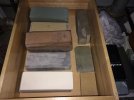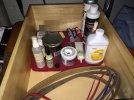dkb45
Gold Member
- Joined
- Dec 16, 2012
- Messages
- 4,458
The title sounds melodramatic, but I stand by it. I hate you all for ruining my Worksharp. I have been toying with the idea for a new sharpener after I noticed that no matter how well I work with my WS I cannot get it to hair whittling. I finally bought some sandpaper as a "why not?" purchase. I now hate you all.
My first edge from sandpaper is far from even and pretty, but damn is it sharp. Just off the 2k paper I was able to shave somewhat cleanly. I now have a dull mirror finish on where I sharpened after stropping, and my edge is nearing hair whittling. Sandpaper was slower, but not terribly so. The 30 sharpening was only increased to a little over an hour, including using my DMT XC to reprofile S30V. Now my WS edges just aren't up to snuff, and I will need to spend about 10 hours redoing all of my knives. I hate you all. My quest for a sharper edge made my $70 sharpener useless.
Obviously I don't hate you all, you are just all dead to me now... You money wasting monsters!
My first edge from sandpaper is far from even and pretty, but damn is it sharp. Just off the 2k paper I was able to shave somewhat cleanly. I now have a dull mirror finish on where I sharpened after stropping, and my edge is nearing hair whittling. Sandpaper was slower, but not terribly so. The 30 sharpening was only increased to a little over an hour, including using my DMT XC to reprofile S30V. Now my WS edges just aren't up to snuff, and I will need to spend about 10 hours redoing all of my knives. I hate you all. My quest for a sharper edge made my $70 sharpener useless.
Obviously I don't hate you all, you are just all dead to me now... You money wasting monsters!




